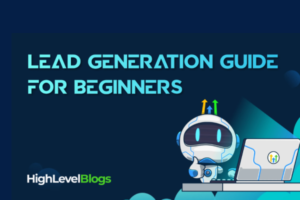Lead Generation Guide for Beginners
Leads. Everyone is after them, and while generating them might seem like this daunting process that takes a huge amount of resources, it doesn’t have to be that way (especially if you’re just starting out!)
That’s why, in this article, we’ll review the basics of lead generation. From understanding what leads to the types of leads you might encounter and proven tips to help you get started, we’ll leave no stone unturned!
What is a Lead?
Before we get too into the weeds, it’s best to review some basic concepts. So… what is a lead?
Simply put, a lead is someone who has indicated that they’re interested in the products or services offered by a business through direct and/or indirect contact.

Let’s take a step further and look at the main types of leads:
- New lead: someone who interacts for the first time with a business.
- Working lead: someone the business is currently having an active conversation with.
- Nurturing lead: someone who is not interested in buying right away, but might be in the future.
- Unqualified lead: someone who declined the business’ offer and is uninterested in what you offer.
- Qualified lead: someone who is interested in becoming a paying customer of the business.
What is Lead Generation?
Now that you understand what leads are and the main types, we can move to the process of generating them.
Lead generation refers to getting prospects to interact with your business and increasing their interest along the way, all with the end goal of converting them into customers.
Let’s take a look at an example of the lead-generation process and its steps.
- The first thing that has to happen is discovery. A user needs to find a business through a marketing channel like a blog, social media, or even a website.
- This user clicks on a call-to-action button that is designed to take the user to…
- A landing page where the business can start having a conversation with the prospect. This conversation might start with a lead form that the prospect will fill out in exchange for something valuable to them. This turns the prospect into…
- A new lead!
As you can see, there are many moving parts here. In the first stage, you need to have interesting and compelling marketing channels that will help you get your prospect’s attention. Then, you need to have a clear call to action and, finally, a good enough offer or lead magnet that convinces the prospect to share their info with you.
B2B Lead Generation
Now, it’s to take a closer look at how to actually generate leads. This time, we’ll focus on B2B lead generation to narrow it even further.
B2B lead generation is a bit different from what we’ve discussed in this article. Instead of creating a list of possible customers who might eventually purchase products/services directly from a business, you’ll seek to build connections with businesses rather than individuals.
This makes B2B lead generation a bit different since most tactics used for B2C leads probably won’t work as well in this case.
Moreover, sales teams can only work when there’s an actual real person on the other side of the line. That’s why, for B2B lead generation, it’s not just about gathering leads; it’s about getting qualified leads from promising sources!

B2B Lead Generation Tactics
Now, let’s take a look at four strategies for B2B lead generation that you can get started with:
- Content is King: yeah – we’ve all heard that before. But it’s truly a no-brainer. You must be looking to position your business as the go-to guru in your industry by creating compelling content that addresses the pain points and challenges your potential B2B clients face.
- Webinars and Virtual Events: a good way to get B2B leads, while also providing value AND positioning yourself as a key player in your field is by hosting educational webinars, workshops, and virtual events to showcase your expertise, address common challenges, and demonstrate the value of your products or services.
- Irresistible Gated Content: this comes as a footnote to the previous point, but you must create valuable resources that entice prospects to provide their contact information.
- Referral Programs: encourage satisfied customers, partners, and industry influencers to refer leads to your business in exchange for incentives or rewards.
The Takeaway
Look, it’s important to remember that lead generation is not a one-size-fits-all type of thing. You’ll need to try and test new strategies, be agile, keep researching, and always keep the needs of your audience front and center. With time, results will start coming in!
And once that happens, you’ll need a tool that helps you manage that steady flow of leads. That’s where HighLevel comes in!
With tools that allow you to automate your lead management, you’ll be able to focus on what really matters: getting promising, qualified leads! Interested in learning how this goes down? Check out the HighLevel Platform and test drive it for a 14 day free trial.

Boost Your Brand: Top 8 Items Small Businesses Should Put Their Logo On in 2024
In today’s competitive market, establishing a strong brand presence is crucial for the success of any small business. One effective way to promote your brand

Lead Generation Guide for Beginners
Leads. Everyone is after them, and while generating them might seem like this daunting process that takes a huge amount of resources, it doesn’t have to

From and $81K ticket to the Current Odds Travis Kelce will Propose To Taylor Swift: Here are the Stats That Will Define the 2024 Super Bowl
by: Paul Mueller, Founding Editor, Players Tribune The Super Bowl is the only sporting event in which people talk during the game and shut up

Navigating Social Media
Navigating Social Media, even if you are not a Millennial By: Gary Robinson, CEO, Inside Line The internet and the world have changed

5 Rules For Choosing Your Brand Colors
Children assign personality traits and emotions to stuffed animals. Adults subconsciously do the same thing. For example, you wouldn’t buy your child a stuffed toy

The Secret Sauce for Start-Up Success: Consistency in Social Media Posting
In the fast-paced world of start-up businesses, every move matters. From building brand awareness to connecting with your target audience, it’s crucial to make every
